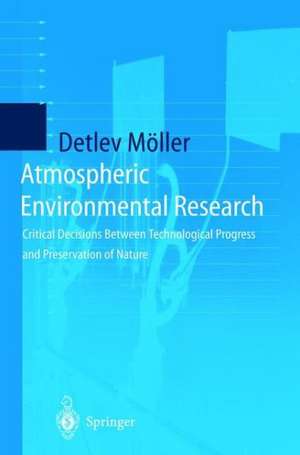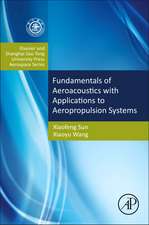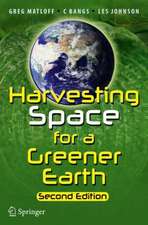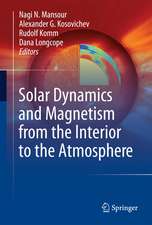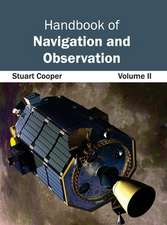Atmospheric Environmental Research: Critical Decisions Between Technological Progress and Preservation of Nature
Editat de Detlev Mölleren Limba Engleză Paperback – 22 oct 2012
Preț: 382.75 lei
Nou
Puncte Express: 574
Preț estimativ în valută:
73.26€ • 79.61$ • 61.58£
73.26€ • 79.61$ • 61.58£
Carte tipărită la comandă
Livrare economică 21 aprilie-05 mai
Preluare comenzi: 021 569.72.76
Specificații
ISBN-13: 9783642635656
ISBN-10: 3642635652
Pagini: 204
Ilustrații: XIV, 186 p.
Dimensiuni: 155 x 235 x 11 mm
Greutate: 0.29 kg
Ediția:Softcover reprint of the original 1st ed. 1999
Editura: Springer Berlin, Heidelberg
Colecția Springer
Locul publicării:Berlin, Heidelberg, Germany
ISBN-10: 3642635652
Pagini: 204
Ilustrații: XIV, 186 p.
Dimensiuni: 155 x 235 x 11 mm
Greutate: 0.29 kg
Ediția:Softcover reprint of the original 1st ed. 1999
Editura: Springer Berlin, Heidelberg
Colecția Springer
Locul publicării:Berlin, Heidelberg, Germany
Public țintă
ResearchDescriere
This is an extended version of lectures that were held at the summer workshop Atmosphiirische Umweltforschung im Spannungsfeld zwischen Technik und Natur (At mospheric Environmental Research between Technology and Nature) at the Techni 16, 1996. We were very happy to have Paul J. Crutzen, cal University in Cottbus on July winner of the Nobel Prize for chemistry in 1995, presenting the key lecture on glo bally changing chemistry in the atmosphere. Over the last decades, atmospheric chem istry has been established step by step, not just as an applied discipline of chemistry, but also as a key discipline for our understanding of air pollution, biogeochemical cycling, and climactic processes as well. In fact, the new definition of meteorology as the science of physics and chemistry of the atmosphere expresses this development very well. The chemistry of the atmosphere is strongly influenced by anthropogenic emissions, even on a global scale. As a result of emissions and chemical reactions, the chemical composition of the atmosphere influences the ecosystems directly via depo sition of trace substances, and indirectly by changing the physical climate. Therefore, in this book we combined state-of-the-art lectures describing the physical and chemi cal status of the atmosphere and selected issues representing the interface between atmosphere, technology and nature. Oxidising capacity, heterogeneous processes and acidity still remain as key issues in atmospheric chemistry, even in regions where efficient air control measures have been adopted resulting in reduction of primary atmospheric pollutants.
Cuprins
I The Global Approach.- 1 Global Problems of Atmospheric Chemistry — The story of Man’s Impact on Atmospheric Ozone.- 1.1 Stratospheric Ozone.- 1.1.1 The Chemistry.- 1.1.2 Man’s Impact on Stratospheric Ozone.- 1.2 Tropospheric Ozone.- 1.3 Topical Problems in Atmospheric Chemistry.- 1.3.1 Observations of the Tropospheric Ozone.- 1.3.2 Long-Term Observations of Properties of the Atmosphere.- 1.3.3 Intensive Measurement Campaigns.- 1.3.4 Cloud Transport.- 1.3.5 Chemical Interactions with Hydrometeors.- 1.3.6 Photolysis Rates in Cloudy Atmospheres.- 1.3.7 Biogenic Sources of Hydrocarbons, CO, and NO.- 1.3.8 Potential Role of Halogen Radicals in Ozone Destruction.- 1.3.9 Heterogeneous Reactions on Aerosol Particles.- 1.3.10 Ozone/Climate Feedbacks in the Stratosphere.- References.- 2 Can Laboratory Data be Related with the Real World?.- 2.1 Introduction.- 2.2 Anthropogenic Ozone: Models versusReality.- 2.3 A Brief History of Atmospheric Ozone Research.- 2.4 Laboratory Studies.- 2.5 The Perturbed Stratosphere.- 2.6 Summary and Conclusions.- References.- 3 An Example for a Man-Made Induced Feedback on the Global Oxidation Capacity: The Possible Increase of Atmospheric ?2O2 Concentrations.- 3.1 Introduction.- 3.2 Atmospheric Chemistry of Hydrogen Peroxide (Budget Between Sources and Sinks).- 3.3 Explanation for the H2O2 Increase Found in Greenland Ice Cores.- References.- II Nature and Technology in Conflict?.- 4 Forest Soil Reaction to Drastic Changes in Sulphur and Alkaline Dust Deposition in Three Scots Pine Ecosystems in Northeast Germany.- 4.1 Introduction.- 4.2 Materials and Methods.- 4.2.1 Experimental Sites and Soils.- 4.2.2 Field Measurements and Soil Samples.- 4.2.3 Analytical Methods.- 4.3 Results.- 4.3.1 General Soil Physical and Chemical Properties.- 4.3.2 Inorganic Sulphate Fractions.- 4.3.3 Soil Solution Composition.- 4.3.4 Element Fluxes.- 4.4 Discussion.- 4.4.1 Element Budgets and Proton Loads of the Humus Layers.- 4.4.2 Sulphate Dynamics and Element Budgets of the Bw Horizons.- 4.5 Conclusions.- Acknowledgements.- References.- 5 Results of the European Auto-Oil Programme: Effects of Future European Exhaust Emissions from Road Transport on the Air Quality of European Cities.- 5.1 Introduction.- 5.2 Exhaust Emission Development.- 5.3 Effects on Air Quality.- 5.3.1 Air Quality Targets.- 5.3.2 Registration of Current Air Quality.- 5.3.3 Identification of All Emission Sources.- 5.3.4 Air Quality Forecast.- 5.3.5 Cost-Benefit Analysis.- 5.4 Summary and Conclusion.- References.- III Consequences of a Changing Atmosphere.- 6 Is the Oxidising Capacity of the Troposphere Changing?.- 6.1 Introduction.- 6.2 Oxidising Efficiency.- 6.3 Influence of the Alkane Chemistry on the Oxidising Capacity.- 6.4 Chemistry of Biogenic VOCs and its Influence on Photooxidant Formation.- 6.4.1 Isoprene.- 6.4.2 Monoterpenes.- 6.4.3 Oxygenated Compounds.- 6.5 Atmospheric Chemistry of Aromatic Hydrocarbons.- 6.6 Atmospheric Formation of HONO as a Source of OH Radicals.- 6.7 Concluding Remarks.- Acknowledgements.- References.- 7 Five-Year Record of Ozone at Mt. Brocken (Germany) — Implications for Changing Heterogeneous Chemistry.- 7.1 Introduction.- 7.2 Ozone Seasonal Cycle.- 7.3 Changing Ozone Amplitude.- 7.4 Discussion.- References.- 8 Acid Rain — Gone?.- 8.1 Introduction.- 8.2 What Does Acid Rain Mean?.- 8.2.1 Acids and Bases — Some Definitions and Applications to the Atmosphere.- 8.2.2 The Acidity Concept.- 8.2.3 Acid Deposition: Dry and Wet Deposition versus Emission.- 8.2.4 Acid-Base Relationships and Redox Processes in the Biosphere-Atmosphere Interaction (the Relationship Between Acidifying and Oxidising Capacity).- 8.3 The Precipitation pH History in Germany and Europe Before 1990.- 8.4 The Changing Acidity after German Unification.- 8.4.1 Seehausen Precipitation Chemistry.- 8.4.2 Brocken Cloud Chemistry.- 8.5 Discussion and Conclusions.- References.
Caracteristici
The main benefit of this book is given from summarizing key questions and present knowledge on the field of interactions between atmosphere, technology and nature.
